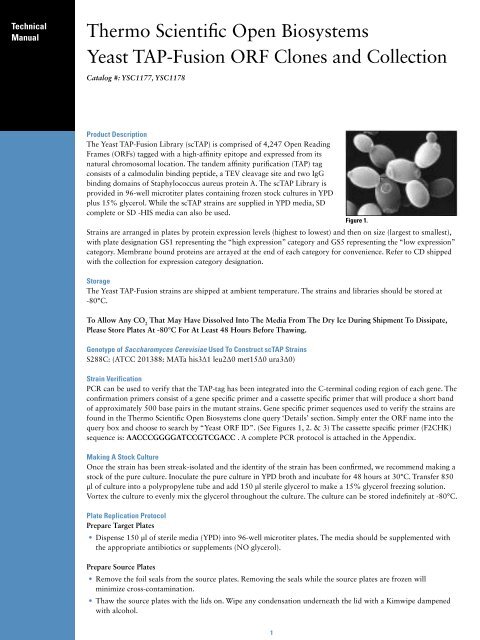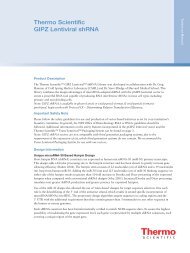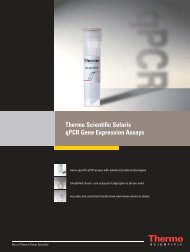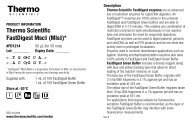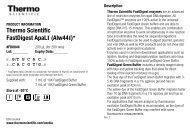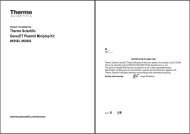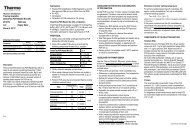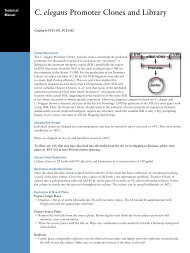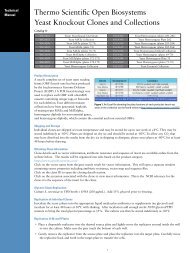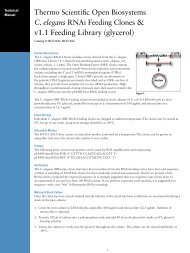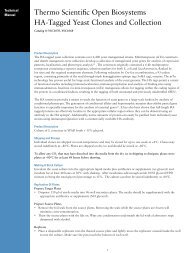Yeast TAP Fusion ORF Clones and Collection ... - Thermo Scientific
Yeast TAP Fusion ORF Clones and Collection ... - Thermo Scientific
Yeast TAP Fusion ORF Clones and Collection ... - Thermo Scientific
Create successful ePaper yourself
Turn your PDF publications into a flip-book with our unique Google optimized e-Paper software.
Technical<br />
Manual<br />
<strong>Thermo</strong> <strong>Scientific</strong> Open Biosystems<br />
<strong>Yeast</strong> <strong>TAP</strong>-<strong>Fusion</strong> <strong>ORF</strong> <strong>Clones</strong> <strong>and</strong> <strong>Collection</strong><br />
Catalog #: YSC1177, YSC1178<br />
Product Description<br />
The <strong>Yeast</strong> <strong>TAP</strong>-<strong>Fusion</strong> Library (sc<strong>TAP</strong>) is comprised of 4,247 Open Reading<br />
Frames (<strong>ORF</strong>s) tagged with a high-affinity epitope <strong>and</strong> expressed from its<br />
natural chromosomal location. The t<strong>and</strong>em affinity purification (<strong>TAP</strong>) tag<br />
consists of a calmodulin binding peptide, a TEV cleavage site <strong>and</strong> two IgG<br />
binding domains of Staphylococcus aureus protein A. The sc<strong>TAP</strong> Library is<br />
provided in 96-well microtiter plates containing frozen stock cultures in YPD<br />
plus 15% glycerol. While the sc<strong>TAP</strong> strains are supplied in YPD media, SD<br />
complete or SD -HIS media can also be used.<br />
Strains are arranged in plates by protein expression levels (highest to lowest) <strong>and</strong> then on size (largest to smallest),<br />
with plate designation GS1 representing the “high expression” category <strong>and</strong> GS5 representing the “low expression”<br />
category. Membrane bound proteins are arrayed at the end of each category for convenience. Refer to CD shipped<br />
with the collection for expression category designation.<br />
Storage<br />
The <strong>Yeast</strong> <strong>TAP</strong>-<strong>Fusion</strong> strains are shipped at ambient temperature. The strains <strong>and</strong> libraries should be stored at<br />
-80°C.<br />
To Allow Any CO 2 That May Have Dissolved Into The Media From The Dry Ice During Shipment To Dissipate,<br />
Please Store Plates At -80°C For At Least 48 Hours Before Thawing.<br />
Genotype of Saccharomyces Cerevisiae Used To Construct sc<strong>TAP</strong> Strains<br />
S288C: (ATCC 201388: MATa his3Δ1 leu2Δ0 met15Δ0 ura3Δ0)<br />
Strain Verification<br />
PCR can be used to verify that the <strong>TAP</strong>-tag has been integrated into the C-terminal coding region of each gene. The<br />
confirmation primers consist of a gene specific primer <strong>and</strong> a cassette specific primer that will produce a short b<strong>and</strong><br />
of approximately 500 base pairs in the mutant strains. Gene specific primer sequences used to verify the strains are<br />
found in the <strong>Thermo</strong> <strong>Scientific</strong> Open Biosystems clone query ‘Details’ section. Simply enter the <strong>ORF</strong> name into the<br />
query box <strong>and</strong> choose to search by “<strong>Yeast</strong> <strong>ORF</strong> ID”. (See Figures 1, 2. & 3) The cassette specific primer (F2CHK)<br />
sequence is: AACCCGGGGATCCGTCGACC . A complete PCR protocol is attached in the Appendix.<br />
Making A Stock Culture<br />
Once the strain has been streak-isolated <strong>and</strong> the identity of the strain has been confirmed, we recommend making a<br />
stock of the pure culture. Inoculate the pure culture in YPD broth <strong>and</strong> incubate for 48 hours at 30°C. Transfer 850<br />
μl of culture into a polypropylene tube <strong>and</strong> add 150 μl sterile glycerol to make a 15% glycerol freezing solution.<br />
Vortex the culture to evenly mix the glycerol throughout the culture. The culture can be stored indefinitely at -80°C.<br />
Plate Replication Protocol<br />
Prepare Target Plates<br />
• Dispense 150 μl of sterile media (YPD) into 96-well microtiter plates. The media should be supplemented with<br />
the appropriate antibiotics or supplements (NO glycerol).<br />
Prepare Source Plates<br />
• Remove the foil seals from the source plates. Removing the seals while the source plates are frozen will<br />
minimize cross-contamination.<br />
• Thaw the source plates with the lids on. Wipe any condensation underneath the lid with a Kimwipe dampened<br />
with alcohol.<br />
1<br />
Figure 1.
Replicate<br />
• Gently place a disposable replicator into the thawed source plate <strong>and</strong> lightly move the replicator around inside<br />
the well to mix the culture. Make sure to scrape the bottom of the plate of the well.<br />
• Gently remove the replicator from the source plate <strong>and</strong> gently place the replicator into the target plate. Gently<br />
move the replicator back <strong>and</strong> forth in the target plate to transfer cells.<br />
• Discard the replicator.<br />
• Place the lids back on the source plates <strong>and</strong> target plates.<br />
Overview<br />
To facilitate global protein analyses, Dr. Erin<br />
O’Shea <strong>and</strong> Dr. Jonathan Weissman (UCSF)<br />
have created a Saccharomyces cerevisiae<br />
fusion library where each <strong>ORF</strong> is tagged with<br />
a high-affinity epitope <strong>and</strong> expressed from<br />
its natural chromosomal location. Through<br />
immunodetection of the common tag, a<br />
resource now exists that provides a census<br />
of proteins expressed during log-phase<br />
growth <strong>and</strong> quantifies their absolute levels.<br />
Characterization of this library revealed that<br />
~80% of the proteome is expressed during<br />
normal growth conditions. The abundance of<br />
proteins ranged from fewer than 50 to more<br />
than 10 6 molecules/cell with many, including<br />
essential proteins <strong>and</strong> most transcription<br />
factors, having levels not readily detectable by<br />
other proteomic techniques, nor predictable<br />
by mRNA levels or codon bias measurements<br />
(Figures 2 & 3) 1 .<br />
Figure 2. Protein Detection 1<br />
The <strong>Yeast</strong> <strong>TAP</strong>-<strong>Fusion</strong> Library allows the<br />
purification <strong>and</strong> selection of the entire<br />
yeast proteome <strong>and</strong> associated components<br />
using two simple affinity selection steps<br />
in t<strong>and</strong>em, enabling the development of a<br />
range of high-throughput functional assays.<br />
A collection of <strong>ORF</strong> specific oligonucleotide<br />
primers was synthesized. Each primer pair<br />
possessed shared 3’ ends that allowed for<br />
PCR amplification of a common insertion cassette, as well as gene-specific 5’ ends that allowed for the precise<br />
introduction, through homologous recombination, of the amplified insertion cassettes as a perfect in-frame fusion<br />
at the C-terminal end of the coding region of each gene (Figure 4) 1 Figure 4. Insertion of C-terminal <strong>TAP</strong> cassette<br />
.<br />
1<br />
The C-terminal <strong>TAP</strong> insertion cassette contains the coding region for a modified version of the <strong>TAP</strong> (T<strong>and</strong>em<br />
Affinity Purification) tag, which consists of a calmodulin binding peptide, a TEV cleavage site <strong>and</strong> two IgG binding<br />
domains of Staphylococcus aureus protein A, as well as a selectable marker. In total, successful integrants were<br />
obtained for 98% of all <strong>ORF</strong>s annotated in the Saccharomyces Genome Database (as of April 2001), including<br />
93% of all essential <strong>ORF</strong>s in haploid yeast.<br />
Useful Websites<br />
Séraphin Group <strong>TAP</strong> method<br />
http://www-db.embl-heidelberg.de/jss/servlet/de.embl.bk.wwwTools.GroupLeftEMBL/ExternalInfo/seraphin/<strong>TAP</strong>.html<br />
O’Shea Lab<br />
http://www.ucsf.edu/ekolab/<br />
Weismann Lab<br />
http://www.ucsf.edu/jswlab/<br />
Saccharomyces Genome Database<br />
http://www.yeastgenome.org/<br />
2<br />
Figure 3. Protein Detection per Cell 1
Reference<br />
1 Ghaemmaghami, S. et al. Global analysis of protein expression in yeast. Nature 425, 737-741 (16 October 2003).<br />
Additional Literature<br />
Rigaut, G. et al. A generic protein purification method for protein complex characterization <strong>and</strong> proteome<br />
exploration. Nat Biotechnol 17, 1030-2 (1999).<br />
Gavin, A. C. et al. Functional organization of the yeast proteome by systematic analysis of protein complexes.<br />
Nature 415, 141-7 (2002).<br />
Appendix<br />
Liquid Culture PCR<br />
1. Grow cells to stationary phase.<br />
2. Transfer 200 μl of culture to a PCR tube.<br />
3. Spin down cells <strong>and</strong> discard supernatant by aspiration.<br />
4. Suspend cells in 20 μl of 0.2% SDS solution.<br />
5. Boil cell suspension at 99°C for 10 min using PCR machine.<br />
6. Add 1.5 (0.6) μl of boiled cell suspension to the PCR reaction mixture of final 50 (20) μl volume:<br />
40.5 (16.2) μl H 2 O<br />
5 (2) μl 10x Taq buffer<br />
1.5 (0.6) μl 2 mM each dNTP<br />
0.5 (0.2) μl 50 μM forward primer<br />
0.5 (0.2) μl 50 μM reverse primer<br />
0.5 (0.2) μl 5 U/μl Taq polymerase<br />
0.1 (0.04) μl 10 mg/ml RNase<br />
* For Library Construction<br />
(1) 0.6 μl boiled cells<br />
+<br />
(2) 2 μl 5 μM CHK primer<br />
+ (x1300)<br />
(3) 14.5 μl H2O :18.85 ml<br />
2 μl 10x Taq buffer :2.6 ml<br />
0.5 μl 2 mM each dNTP :0.65 ml<br />
0.2 μl 50 μM F2CHK :260 μl<br />
0.2 μl 5 U/μl Taq pol. :260 μl<br />
0.04 μl 10 mg/ml RNase :50 μl<br />
FAQS/Troubleshooting<br />
For answers to questions that are not addressed here, please email technical support at<br />
openbiosystems@thermofisher.com with your question, your sales order or purchase order number <strong>and</strong> the catalog<br />
number or clone ID of the construct or collection with which you are having trouble.<br />
3<br />
Contact Information<br />
Technical Support<br />
Tel: 1.888.412.2225<br />
Fax: 1.256.704.4849<br />
openbiosystems@<br />
thermofisher.com<br />
© 2009 <strong>Thermo</strong> Fisher<br />
<strong>Scientific</strong> Inc. All rights<br />
reserved. Trademarks<br />
are the property of their<br />
respective owners. All<br />
other trademarks are<br />
the property of <strong>Thermo</strong><br />
Fisher <strong>Scientific</strong> Inc.<br />
<strong>and</strong> its subsidiaries. For<br />
Research Use Only.


